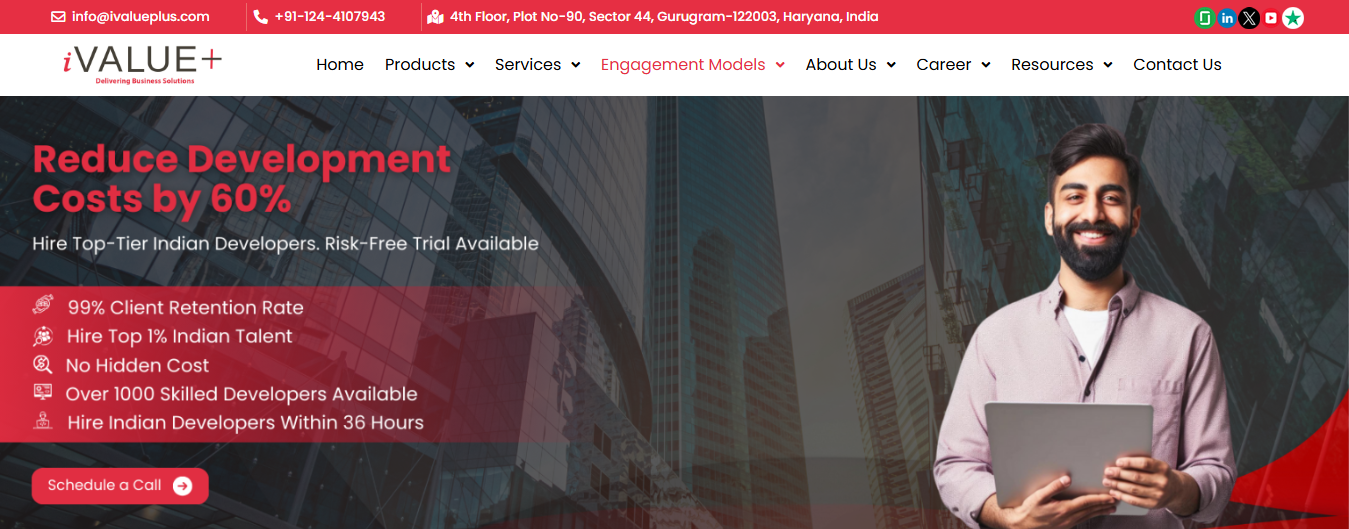Explore whether IT staff augmentation services are right for your...

Staff Augmentation Services for Startups: Process, Pitfalls, and Proven Strategies
July 8, 2025- augmentation model
- dedicated development team
- Flexible development models
- it resource augmentation
- it staff augmentation services
- it staff augmentation services in india
- IT talent shortages
- IT team augmentation
- Pros and cons of IT staff augmentation
- staff augmentation for startup
- staff augmentation for startups
- staff augmentation vs outsourcing
- Startup talent strategy
- Startup team expansion
- startup tech staffing

Are IT Staff Augmentation Services the Right Fit for Your Startup?
Hiring the right tech talent is a challenge for startups. Between budget constraints, limited in-house expertise, and rapidly evolving project needs, many founders ask: “Are IT staff augmentation services the right fit for my startup?”
In this comprehensive guide, we’ll explore what IT staff augmentation services are, their benefits and drawbacks, the engagement models available, and whether they align with your growth ambitions. We’ll also offer proven strategies to maximize success—and help you avoid common pitfalls.
What Are IT Staff Augmentation Services?
IT staff augmentation services allow startups to temporarily add skilled professionals—developers, QA, UI/UX, DevOps, data engineers—to their team. Instead of hiring full-time employees, you tap into pre‑vetted IT resource augmentation providers, integrating experts into your workflows, tools, and sprints.
Unlike traditional outsourcing, augmentation means the external resource works directly within your team—reporting to your managers and aligning with your vision.
Why Startups Choose IT Staff Augmentation Services
Startups choose staff augmentation services for startups for key reasons:
- Speed: Add developers in weeks, not months, to accelerate MVP launch or feature rollout.
- Cost Efficiency: Avoid overhead—no recruiting, no benefits, no full-time salaries.
- Expertise on Demand: Need AI engineers or DevOps specialists? Get them instantly, without long hiring cycles.
- Flexibility: Scale your startup team expansion up/down without layoffs.
- Focus: Let your core team drive product and customer growth, while a dedicated development team handles delivery.
In short, augmentation offers a flexible, budget-smart way to bridge the IT talent gap—without the delays of traditional hiring processes.
Popular IT Staff Augmentation Models
When exploring IT team augmentation, you’ll typically encounter these augmentation models:
- Resource-Level Augmentation
Hire individual professionals (e.g., React developer, QA engineer) to fill specific roles in your scrum team.
- Team Augmentation
Bring in a dedicated multi-role unit—frontend, backend, QA, project manager—to deliver part of your product or sprint cycle.
- Project-Based Augmentation
Outsource a full module or feature. The profiled team executes it end-to-end within your toolchain and guidance.
Choose the approach based on scope, duration, and your internal capacity to integrate the team.

Key Benefits of IT Staff Augmentation Services
- Speed to Delivery
Augmenters are ready and pre-vetted—your dev velocity doubles within days. No waiting for recruiter cycles or visa paperwork.
- Cost Savings
Your startup pays only for hours worked—no benefits, taxes, or real estate. Typical cost drop: 40–60% vs local hiring.
- Scalability on Demand
Need to double the team next quarter? With augmentation, you can scale fluidly without HR delays.
- Access to Niche Skills
High-demand roles like data science or cloud architecture are often easier to source through augmentation than hiring full-time.
- Risk Mitigation
Spot a misfit during the trial? You can easily offboard without legal entanglements.
- Seamless Team Integration
Augmented staff become part of your team—sprinting, standups, retros—and follow your tech stack and practices.
Potential Downsides to Consider
- Cultural Misalignment
Bring someone on board who doesn’t align with your startup culture, and productivity suffers. Emphasize soft skills during hiring.
- Onboarding Overhead
Even pre-vetted professionals need time to understand your systems. Plan mentorship and knowledge-sharing sessions.
- Scope Creep
Without strict contracts, cost or workload may expand beyond initial scope. Use performance KPIs and scope controls.
- Dependency Risk
Relying too much on augmentation can hinder internal capacity building. Balance with ongoing in-house development.
- IP and Data Security
Without proper agreements and security measures, a disgruntled contractor could pose threats. Use NDAs, secure repos, and access controls.
Staff Augmentation vs Outsourcing vs Time & Material
Model | Control | Flexibility | Ideal For |
IT Staff Augmentation Services | Full team control—your direction | High | Tech-led startups |
Outsourcing | Deliverable-based control only | Low to medium | Fixed-scope modules |
Time & Material | Partial control, defined rates | Medium | Agile, adaptive projects |
Augmentation offers complete alignment with your team and sprint cycles, making it ideal for evolving and innovation-led startups.
When IT Staff Augmentation Is the Right Fit
Staff augmentation is a strategic fit when you:
- Need product sprint acceleration (MVP, feature updates)
- Require niche skills not present internally
- Want agile scaling without hiring overhead
- Prioritize culture, control, and real-time collaboration
- Are open to managing remote or hybrid teams
When It Might Not Fit
Reconsider if you:
- Always plan to close the skill gap by hiring full-time
- Have no capacity to manage remote team members
- Prefer handing over the entire product delivery (outsourcing fits better)
- Need tightly scoped, less iterative development cycles
How to Make It Work: Best Practices
A. Document Clear Requirements
- Define role, tech stack, deliverables
- Set success metrics (velocity, release frequency)
B. Implement a Multi-Stage Hiring Process
- Portfolio & design reviews
- Technical interviews (live or recorded coding tests)
- Culture and communication fit
C. Onboarding Protocol
- Provide repo and system access
- Align them with mentors and dev standards
- Include them in meetings from day one
D. Communication Rhythm
- Daily standups
- Weekly demos and feedback sessions
- Monthly strategic check-ins
E. Track KPIs
- Code quality, PR review time, issue backlog
- Velocity metrics
- Delivery accuracy (%)—features delivered on time
F. Conduct Regular Retrospectives
Continue improvements and address gaps early.
G. Plan Exit/Escalation Triggers
Document benchmark evaluations and exit terms rather than assuming continuity.
Real-Startup Use Cases
Example 1: Marketplace MVP
Challenge: Build marketplace MVP in 3 months
Solution: Augmented 2 React engineers + 1 backend Ruby dev
Result: MVP delivered in 10 weeks, pre-launch fundraising enabledExample 2: SaaS Enterprise Integration
Challenge: Integrate an enterprise with ERP and AI modules
Solution: Augmented cloud engineer and data scientist
Result: Integration complete within sprint cycle; enterprise contract wonExample 3: 24/7 Support Coverage
Challenge: Global user base needed round-the-clock bug fixes
Solution: Augmented support/development team across India and UTC +2
Result: SLA response time improved from 12h to <2h; churn dropped 25%

Choosing the Right IT Staff Augmentation Partner
Look for a partner that offers:
- Deep tech vetting (coding tests, past projects)
- Transparent pricing (clear T&M rates, no hidden fees)
- Cultural alignment (English fluency, timezone overlap)
- Security standards (NDAs, secure systems, IP clauses)
- Flexibility (from single developers to full teams)
Cost & Contracting Models
Simple contract structures include:
- Monthly T&M: Pay-per-hour on timecards
- Fixed roles: $X/month per developer
- Escrow & milestones: Ideal for short engagements
Ensure the contract clearly defines:
- Termination clauses
- Knowledge handover
- IP and confidentiality
- Performance review cadence
Measuring Success: What to Track
Track these KPIs to evaluate whether augmentation is worth it:
- Sprint velocity (% increase month-over-month)
- Feature cycle time
- Bug backlog trends
- Support ticket SLA compliance
- Internal team satisfaction (survey)
Conclusion
Choose IT staff augmentation services if you want:
- Fast, flexible access to talent
- Tech-led team control and ownership
- Minimal hiring overhead, maximum agility
- Ability to scale up/down without risk
Avoid it if:
- You only need fixed deliverables
- You plan on hiring full-time ASAP
- You lack capacity to manage remote team members
Ready to scale your startup with expert tech talent?
Contact us today to explore flexible, cost-effective staff augmentation solutions tailored for your business.
FAQs
Q: What is IT staff augmentation?
A model to rapidly add on-demand tech talent to your team—developers, DevOps, QA, UI/UX—without full-time hires or outsourcing.
Q: How is staff augmentation different from outsourcing?
Staff augmentation integrates professionals into your workflows with full control; outsourcing hands off deliverables for module-based work.
Q: What are the pros and cons of IT staff augmentation?
Pros: speed, cost‑effectiveness, niche skills, control. Cons: cultural fit, onboarding effort, scope creep, dependency risks.
Q: Can staff augmentation solve IT talent shortages?
Yes—you gain immediate access to highly skilled professionals without lengthy recruiting cycles.
Q: How do I choose between augmentation and outsourcing?
Choose augmentation if you want process control and cultural alignment; choose outsourcing for fixed‑scope, hands-off projects.
Recent Post
Staff Augmentation Services for Startups: Process, Pitfalls, and Proven Strategies
Explore the staff augmentation services for startups—process, pitfalls, types, and...
The Strategic ODC Benefits You Can’t Afford to Ignore in 2025-26
Discover the strategic ODC benefits you can’t afford to ignore...








